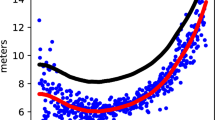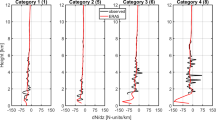Abstract
During the last 2 decades, Global Positioning System (GPS) measurements have become a very important data-source for ionospheric studies. However, it is not a direct and easy task to obtain accurate ionospheric information from these measurements because it is necessary to perform a careful estimation of the calibration constants affecting the GPS observations, the so-called differential code biases (DCBs). In this paper, the most common approximations used in several GPS calibration methods, e.g. the La Plata Ionospheric Model (LPIM), are applied to a set of specially computed synthetic slant Total Electron Content datasets to assess the accuracy of the DCB estimation in a global scale scenario. These synthetic datasets were generated using a modified version of the NeQuick model, and have two important features: they show a realistic temporal and spatial behavior and all a-priori DCBs are set to zero by construction. Then, after the application of the calibration method the deviations from zero of the estimated DCBs are direct indicators of the accuracy of the method. To evaluate the effect of the solar activity radiation level the analysis was performed for years 2001 (high solar activity) and 2006 (low solar activity). To take into account seasonal changes of the ionosphere behavior, the analysis was repeated for three consecutive days close to each equinox and solstice of every year. Then, a data package comprising 24 days from approximately 200 IGS permanent stations was processed. In order to avoid unwanted geomagnetic storms effects, the selected days correspond to periods of quiet geomagnetic conditions. The most important results of this work are: i) the estimated DCBs can be affected by errors around ±8 TECu for high solar activity and ±3 TECu for low solar activity; and ii) DCB errors present a systematic behavior depending on the modip coordinate, that is more evident for the positive modip region.
Similar content being viewed by others
References
Abdu MA, Batista IS, Carrasco AJ, Brum CGM (2005) South Atlantic magnetic anomaly ionization: a review and a new focus on electrodynamic effects in the equatorial ionosphere. J Atmos Solar Terrestr Phys 67: 1643–1657. doi:10.1016/j.jastp.2005.01.014
Azpilicueta F, Brunini C, Radicella SM (2006) Global ionospheric maps from GPS observations using modip latitude. Adv Space Res 38(11): 2324–2331. doi:10.1016/j.asr.2005.07.069
Azpilicueta F, Brunini C, Radicella SM (2011) Semi-annual anomaly and annual asymmetry on TOPEX TEC during a full solar cycle. In: Proceedings of 2009 IAG Symposium, international association of Geodesy symposia series 136. ISBN: 978-3-642-20337-4
Brunini C (1998) Global Ionospheric Model from GPS measurements. Doctoral thesis, Facultad de Ciencias Astronómicas y Geofísicas, UNLP. La Plata, Argentina
Brunini C, Azpilicueta F (2009) Accuracy assessment of the GPS-based slant total electron content. J Geod 83: 773–785. doi:10.1007/s00190-008-0296-8
Brunini C, Azpilicueta F (2010) GPS slant total electron content accuracy using single layer model under different geomagnetic regions and ionospheric conditions. J Geod 84: 293–304. doi:10.1007/s00190-010-0367-5
Brunini C, Meza A, Azpilicueta F, Van Zele M, Gende M, Díaz A (2004) A new ionosphere monitoring technology based on GPS. Astrophys Space Sci 290: 415–429
Brunini C, Azpilicueta F, Gende M, Aragón-Ángel A, Hernández-Pajares M, Juan JM, Sanz J (2009) Toward a SIRGAS service for mapping the ionosphere’s electron density distribution. Submitted to IAG symposia series, Springer, Berlin
Dow JM, Neilan RE, Rizos C (2009) The international GNSS Service in a changing landscape of global navigation satellite systems. J Geod 83(3-4): 191–198. doi:10.1007/s00190-008-0300-3
Fu LL, Christensen E, Yamarone C, Lefebvre M, Menard Y, Dorrer M, Escudier P (1994) TOPEX/POSEIDON mission overview. J Geophys Res 99(C12) 24: 369–381
Gonzalez WD, Joselyn JA, Kamide Y, Kroehl HW, Rostoker G, Tsurutani BT, Vasyliunas VM (1994) What is a geomagnetic storm?. J Geophys Res 99(A4): 5771–5792. doi:10.1029/93JA02867
Hernández-Pajares M, Juan JM, Sanz J, Orus R, García-Rigo A, Feltens J, Komjathy A, Schaer SC, Krankowski A (2009) The IGS VTEC maps: a reliable source of ionospheric information since 1998. J Geod 83: 263–275. doi:10.1007/s00190-008-0266-1
Jakowski N, Heise S, Wehrenpfennig A, Schluter S, Reimer R (2002) GPS/GLONASS-based TEC measurements, as a contributor for space weather forecast. J Atmos Solar Terrestr Phys 64(5–6): 729–735. doi:10.1016/S1364-6826(02)00034-2
Nava B, Coïsson P, Miró Amante G, Azpilicueta F, Radicella SM (2005) A model assisted ionospheric electron density reconstruction method based on vertical TEC data ingestion. Ann Geophys 48(2): 313–320
Radicella SM, Leitinger R (2001) The evolution of the DGR approach to model electron density profiles. Adv Space Res 27(1): 35–40. doi:10.1016/S0273-1177(00)00138-1
Rawer, K (ed) (1984) Encyclopedia of physics, geophysics III: part VII. Springer, Berlin, pp 389–391
Sardon E, Rius A, Zarraoa N (1994) Estimation of the transmitter and receiver differential biases and the ionospheric total electron content from global positioning system observations. Radio Sci 29: 577–586. doi:10.1029/94RS00449
Schaer S (1999) Mapping and predicting the earth’s ionosphere using the global positioning system. PhD thesis, Bern University, Bern, Switzerland
Willis P, Fagard H, Ferrage P, Lemoine F, Noll CE, Noomen R, Otten M, Ries JC, Rothacher M, Soudarin L, Tavernier G, Valette JJ (2010) The international DORIS service, steps toward maturity. Adv Space Res 45(12): 1408–1420. doi:10.1016/j.asr.2009.11.018
Author information
Authors and Affiliations
Corresponding author
Rights and permissions
About this article
Cite this article
Conte, J.F., Azpilicueta, F. & Brunini, C. Accuracy assessment of the GPS-TEC calibration constants by means of a simulation technique. J Geod 85, 707–714 (2011). https://doi.org/10.1007/s00190-011-0477-8
Received:
Accepted:
Published:
Issue Date:
DOI: https://doi.org/10.1007/s00190-011-0477-8




